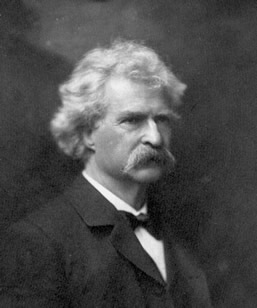Huck and Tom Among the Indians
Huck and Tom Among the Indians takes place on the Oregon Trail from western Missouri, along the Platte river, ending in Sioux territory near Fort Laramie. This is the same route that Twain himself took in 1861 on the way to Nevada, and from which he developed the travel book Roughing It (Blair 84). Walter Blair, the editor of Mark Twain's Hannibal, Huck & Tom observed that several of the events in the short story correspond with those that occurred in Clemens' personal life.
While definitely not his best work, and in some respects an utter failure, Huck and Tom Among the Indians reveals intriguing things about Twain's view of American Indians. The devious nature of the Indians who double-cross and then massacre the loving Mills family, and Peggy's implied brutal rape, eliminate any possibility of a positive racial relationship between whites and American Indians. The story's plot dwindles until it reaches stagnancy; perhaps this is the reason that Twain could not finish the text.
Huck Finn and Tom Sawyer Among the Indians--Brief Article--Audiobook Review
By Janet Julian Grafton
Twain's story begins with Huck, Tom, and the ex-slave Jim heading for Indian country because Tom convinced them that Indians were the splendidest creatures on God's earth. The difference between book Indians and real ones soon becomes apparent. The adventurers join a party of pioneers named Mills who are waiting at the Platte River for Peggy Mills' fiance, Brace Johnson. They are joined by a group of Oglala Sioux warriors who murder the Mills and their three sons and kidnap Peggy and her younger sister Flaxie. Brace, the two adventurous boys, and Jim trail the girls. Just as they are about to sneak into the Indian camp for the rescue, Twain drops the tale in the middle of a sentence.
Nelson takes up the pen and the rest of the story is filled with adventure, violent weather, an Army sergeant who rapes young boys, and Huck's growing love for Peggy Mills. Huck narrates as usual, but he's growing up so his naivete is accompanied by unexpected native wit and survival skills. It's an exciting story with the unbeatable narration of Gardner, who gets Huck's twang just right. Gardner handles the dialects with aplomb. Anyone would travel west with this Huck Finn, a brave, decent boy who grows into a generous, caring man.
Huck Finn and Tom Sawyer among the Indians
I excerpted portions of it for my Mark Twain, Indian Hater posting. Yes, it reveals "intriguing things about Twain's view of American Indians"--particularly the fact that Twain was a racist.
For more on the subject, see Why Not Rewrite Twain's Books? and New Huck Finn Eliminates "Injun."


No comments:
Post a Comment